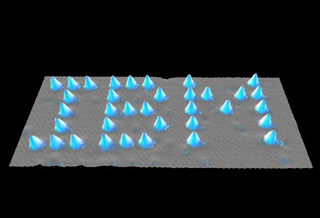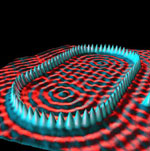Introduction

If anything has defined the nanotechnology age, it has been our increasing ability to manipulate individual atoms and molecules. You cannot flip the pages of the virtually any general journal in the basic sciences or engineering without seeing photographs depicting our new found nano-abilities. Why has this occurred at this particular time? As with most revolutions, the causes are numerous and interrelated. Of special interest has been the development of the scanning tunneling and atomic force microscopes (STM & AFM respectively) developed by Binnig and colleagues[1] of the IBM Corporation. Binnig and Rohrer received the Nobel Prize for Physics in 1986 for their work. Most famously, this invention was soon used to manipulate individual atoms on a surface[2] something that caused a stir among the scientifically literate. The surface plane is of nickel and the deposited atoms are xenon at 4 K. Why these conditions? See the short section on the STM & AFM if you haven’t already done so.
A simple calculation shows that this is an experimental technique, not a manufacturing one. Suppose you want to build a widget, i.e., some small circuit/mechanism/chemical formulation/medical implant/etc. whose total size is 1 micromole. This is a macroscopic entity well outside of the nano region but still quite small; e.g., if its molecular mass were 1000 g/mol, its mass would be 1 mg - really just a speck. But it would still contain 10-6 × NAv elementary particles or 6 × 1017 particles. Suppose each addition to the structure could be built in a microsecond. It will take 6 × 1011 seconds or just shy of 20,000 years to build just one widget!
This is at the heart of a controversy raging in the nano literature. One of the founders of nanotechnology, Drexler[3] has argued vigorously for nanobots, in effect natural robots at the molecular level that can assemble structures molecule by molecule. Smalley[4], one of three Nobel Prize winning discoverers of bucky balls, has made the above contra nano manufacturing argument. Smalley also further argues that the nanobot would be too clumsy and have “sticky fingers”. By the latter is meant that once it picked up a molecular fragment, it would not be easy to let it go.
Another useful technique that has developed over the last few years is Optical Tweezers. This has some things in common with the STM/AFM; it was first demonstrated at about the same time[5], and it can manipulate individual molecular fragments. A number of interesting examples of its use are readily available on-line[6].
We will examine a number of areas in which molecules are arranged using techniques that are somewhere between Drexler’s nanobots and the use of a STM/AFM to manipulate individual atoms and optical tweezers to manipulate single biological molecules. What they have in common is that they use condensed (i.e., liquid, surface, or solid) phases rather than condensing the molecules from a dilute gas phase.
Footnotes and References
[1]. G. Binnig, H. Rohrer, “Scanning Tunneling Microscopy”, Surface Science, (Mar 1983)
[4]. R. E. Smalley, “Of Chemistry, Love and Nanobots”, Sci. Amer., p. 76, (Sept. 2001).
[5]. A. Ashkin, J.M. Dziedzic, J.E. Bjorkholm, S. Chu: "Observation of a single beam gradient force optical trap for dielectric particles", Optics Letters, 11(5), p. 288, (1986); see: http://www.pnas.org/cgi/content/full/94/10/4853?maxtoshow=&HITS=10&hits=10&RESULTFORMAT=&searchid=QID_NOT_SET&FIRSTINDEX=&volume=94&firstpage=4853
[6]. http://www7.nationalacademies.org/bpa/Tweezers.pdf

